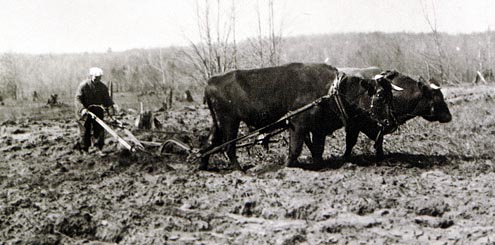Gardening The No-Till Way
By George Graine, Fairfax Master Gardener

Till no more, ye gardeners!
Traditionally, tilling the soil involved a man pushing some heavy implement to turn over the soil. Later, the poor guy was assisted by mules, horses or oxen. This was all in the service of the commonly held notion that plant roots had an ability to “eat” small pieces of soil and that tilling the soil released nutrients that aided plant growth.

Actually, tilling before planting does encourage seedling growth but not for the reasons old-time farmers believed. Tilling mixes air (oxygen) into the soil, which is beneficial on two counts. Soil oxygen is required for roots to grow. And oxygen encourages soil microbes to break down organic matter in the soil so that nutrients such as nitrates and phosphates are released to the plants. So far, so good.
However, too much oxygen accelerates microorganism activity. More active microbes consume large amounts of good organic matter too quickly. This can result in a loosening of the soil so that organic matter is more easily eroded in a rainstorm. It also results in soil carbon combining with atmospheric oxygen to make carbon dioxide, which wafts into the atmosphere. The result is less carbon in the soil, which is not good for soil structure.
What happens when a motorized cultivator such as a rototiller is used? It pulverizes soil, breaking it into a finer texture. Repeat tilling is less than ideal for the long-term health of the soil. It causes hardpan to develop where the blades reach their maximum depth. This makes soil penetration difficult, especially for root crops. Water may also pool at the hardpan layer rather than draining away.
Tilling, particularly mechanized tilling, exposes the soil structure to the elements. Good soil is composed of “crumbs.” Crumbs are little conglomerates of smaller soil particles held together by organic humus. Rototilling breaks down the crumbs, exposing fine particles of soil which can be blown or washed away. Furthermore, these fine particles can fill the porous gaps between crumbs and, with time, clog the soil. This is definitely not a good thing for your garden bed. Since we are often dealing with clay soil in Northern Virginia, aside from erosion, you could experience water-logging and compaction as a result of continuous rototilling and, of course, the aforementioned hardpan layer.
Can you imagine what happens to our friends the earthworms when they come in contact with a rototiller – ugh! Other creatures and microorganisms that inhabit the soil and play important roles in soil ecology are also at risk. In other words, the distribution of nutrients to plants in a timely manner is being disturbed. That is probably why more and more fertilizer is necessary in order to produce a reasonable yield of whatever you plant.
Any soil scientist worth his or her dirt will tell you that no-till gardening is the way to go. How should you do it?
- Design your planting area so that you do not walk over your garden; soil compaction owing to foot traffic is the enemy of the no-till approach.
- You may want to till the garden one time when you start it to correct deficiencies in organic matter or nutrients that are revealed in a soil test.
- Since good soil is the foundation of every garden, amend the garden soil with organic matter (compost) to improve the soil structure and increase nutrients. Mulching on top of the soil will tend to keep the soil in place and reduce weeds. As a “bonus,” the mulch breaks down, enriching the soil. Mulch also keeps soil moist, meaning less watering during the hot summer.
- When it is time to plant, you simply poke a hole in the soil.
You may feel guilty using the no-till method, because you are used to seeing lumps of earth in neat rows. No-till gardening is natural, and the ecology of soil is not turned upside down (pardon the pun). No-till gardening is almost child-like because the method is so simple. Gardening the no-till way will save your soil, your back and your time.
References
Decoding Gardening Advice, Gillman, J. and M. Maynard. Timber Press, 2012.
No-Till: The Quiet Revolution, Huggins, D. and J. Reganold. Scientific American, 2008.
Teaming With Microbes, Lowenfels, J. and W. Lewis. Timber Press, 2006.
Soil Preparation, Niemeira, A (originally by Relf, D. and A. McDaniel). Virginia Cooperative Extension Publication 426-313, revised 2000.
No Till Gardening, Seaman, G. Organic Garden, 2009.
Don’t Take Turns: A Guide to No-Till Gardening, Walliser, J. Hobby Farms, 2013.
Mulch is a Key to No-Till Gardens, Woods, T. Oregon State University Extension Service, 2012.